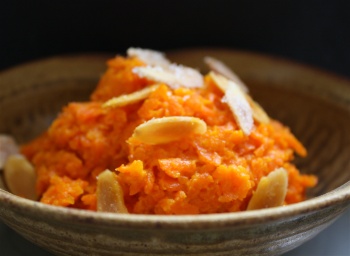"We changed it a little," she said. The milk, the cardamom, almonds for cashews.
It got me thinking about how, as Americans, we all inherit the dishes and traditions of our ancestors from their various distant origins. In my family for example, it's the cannoli. Every holiday, silver trays of the confections were placed on the table for dessert-- one studded with candied citron, the other with chocolate. While the older generations consumed the citron, the kids went for the chocolate. As the years passed and the older folks-- some of them actual Italians-- died off, so did the use of citron. The cannoli we make today are only with chocolate, to suit our Americanized tastes. They are still cannoli, just not ones my Sicilian great-grandmother would be likely to touch. They are still recognizable, but they bear the branding of adaptation, of assimilation.
I know my family isn't alone in this morphing trend. It's how we as a country traditionally have made anything "foreign" or "other" its own. Think pizza or nachos or just about anything Chinese. We take an idea from one place, adapt it to our own needs or desires (the blander version of something exotic perhaps, made with ingredients easily obtainable in our own markets), and the results are familiar, yet different.
That's how I saw Gajar ka Halwa when it was described to me-- strangely familiar (carrots and almonds), yet exotically different (dessert?). Of course, when it was being described, Razili never called it by its Punjabi name. "It's carrot pudding."
It was my favorite dish of the night. And, believe me, there were some great things on that table.
Carrot Pudding
Serves: 4
That's what I'm calling it. The ingredients are hardly exotic, unless you think cardamom is fanciful. In that case, you most likely don't have Central European, Indian, or Persian ancestors, to name a few.
It's a remarkably easy dish to prepare (if you don't mind a lot of stirring), inexpensive, and really, really delicious. I've changed Razili's recipe slightly to suit my own tastes, but of course, that's to be expected, given the sub-theme of today's post.
Ingredients:
3 cups shredded carrot
2 cups whole milk
3 tablespoons of unsalted butter
1/3 cup of sugar
10 to 15 cardamom pods or a heavy pinch of ground cardamom powder
1/4 teaspoon almond extract
Toasted sliced almonds for garnish. I candied mine.
Preparation:
1. Melt butter in the bottom of a wide pan over medium heat. More surface area= faster cooking time, I promise. Add carrots and stir occasionally until soft and thoroughly cooked. About 5 minutes.
2. At the same time, heat milk in a saucepan or microwave, if you're that kind of person. I am, but mine broke and it's low on my priority list to replace it. Add cardamom pods to milk. Bring to a boil, then turn off the heat and let the cardamom steep. Stir occasionally to prevent the milk from forming a skin.
3. Remove cardamom pods from the milk. Add milk to the cooked carrots. Stir constantly to prevent burning. Continue this form of exercise until the all the milk has absorbed/evaporated. The carrot mixture should be a little wet. About 10 -15 minutes. Add sugar and stir for another 3 minutes or so, just until the sugar has melted and absorbed. Turn off heat and stir in almond extract.
4. Place in serving bowl, top with almonds slices and serve warm. Of course, it's still really good eaten cold out of the fridge at midnight as well.
Do what you will, it's your tradition now.
 I'd never thought much of the carrot in terms of dessert food. Before you ask the obvious "But what about carrot cake?" question, yes, I know it exists. I just choose not to acknowledge it any longer, thanks to my volunteering to bake that particular dessert for a friend's wedding several years ago. 150 people to feed and a Barbie-sized oven left me exhausted, but proud of the mission accomplished. I have since moved on. I don't think I'd even uttered the word "carrot" in years.
I'd never thought much of the carrot in terms of dessert food. Before you ask the obvious "But what about carrot cake?" question, yes, I know it exists. I just choose not to acknowledge it any longer, thanks to my volunteering to bake that particular dessert for a friend's wedding several years ago. 150 people to feed and a Barbie-sized oven left me exhausted, but proud of the mission accomplished. I have since moved on. I don't think I'd even uttered the word "carrot" in years.